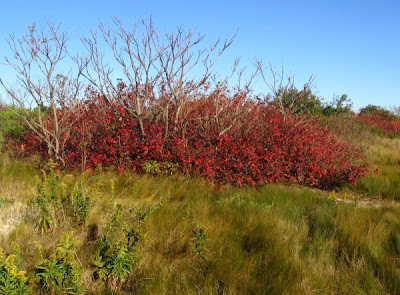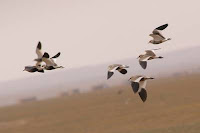Speaking of invasive species, the Times profiled some of the threats facing the widespread forests of New Jersey, New York, and Connecticut. While the acreage covered by forests has increased over the past century, the composition of forests is changing. Many forests occur in smaller plots, many are losing their understory, and invasive plants are replacing native ones in many locations.
From state to state and forest to forest, the situation is variable and dynamic. “There is a lot of healthy forest left,” said Dr. Joan Gardner Ehrenfeld, an expert on invasive species who is a professor in the Department of Ecology, Evolution and Natural Resources at Rutgers University.
But in some areas, multiple threats “are coming together as a sort of a perfect storm,” she said. “There are too many different problems all converging at the same time in the same place, and the multiple effect makes the situation all the more serious.”
These threats, experts say, include suburban sprawl, the impact of marauding invasive plants and insects, climate change and not only acid rain but also, contrarily, lack of rainfall. But in many locales, the implacable browsing of deer on young trees is killing replacement saplings, depleting shade and promoting the growth of invasive plants that smother native species.
The various threats are interwoven. Sprawl leads to forest fragmentation, which in turn encourages invasive plants to proliferate. The overpopulation of white-tailed deer also makes it harder for native plants to survive and easier for invasives to take over. Some invasive plants are distasteful to deer, while the native plants are not.
In some areas the impact is so profound “that it looks like someone took a brown crayon and used a ruler to draw in a brown line and a green line,” Dr. Ehrenfeld said. “The green above stops at a steady line at the height that deer can reach.” Increasingly, “suburbia is uniquely designed to grow and harbor deer,” Ms. Sauer said, “because lawns and flower gardens are high-quality deer delis, and the deer are safe from hunters.” She added, “We have created a physical environment where there is no limit to their growth.”
Forests can heal themselves when they have a population of 5 to 10 deer per square mile, “but now 35 per square mile is common, it’s well over 50 in some places, and in a few places in New Jersey it can be 250 or even more,” Dr. DeVito said. “One overabundant species is sacrificing thousands of other species. We have to recognize that, and deal with it.”
....
And newer invasives are perennially joined by older stalkers. This year some 320,000 acres of New Jersey trees were defoliated by gypsy moth caterpillars, the most since 1990, when more than 431,000 acres of trees experienced leaf loss. A growing concern is the appearance of kudzu, a climbing perennial vine that can reach heights of close to 100 feet and has caused hundreds of millions of dollars in damage to Southern woodlands.
The disappearance of forest's understory and the proliferation of invasives changes the types of animals that can survive there.
Still, some forest managers fear a future of “boring forests” or “trash forests,” with fewer hardwoods and more species like ailanthus and cottonwoods that may transform the region’s wildlife population.
In the worst case, “we are looking forward to forests that look like the landscapes of vacant lots,” Ms. Sauer said. “Alien species, and no complexity. And that level of simplification will affect birds, mammals, butterflies, everything.”
So what types of birds might be affected? The primary impact would be felt by birds that depend on a rich understory for nesting or foraging. These include most thrushes, many warblers (including ovenbirds, black-throated blue warblers, and Kentucky warblers), and fox sparrows, among others. Even some canopy-dwellers, such as
cerulean warblers, start to disappear when the understory is lost or degraded. Studies have shown that
deer exclosure plots and
forests with lower deer density have higher plant and bird diversity.
Most forests profiled in the article will continue to exist for the foreseeable future. They occur on large tracts protected as federal or state public lands for conservation and recreation. What they look like in the future will depend on how well the current threats can be managed.
***
Birders can help with the problem to some extent. One way is to volunteer for invasive species control efforts, if they are available locally. Another is to be careful to use native or noninvasive species for plantings around the home. Here is an
invasive plant identification key, and here are
tips for control and removal. Local native plant societies can provide recommendations for what to plant and where to find them. Here are lists of sources for native plants for
New Jersey and
Maryland, for example.
***

One nonnative invasive tree highlighted by the
Times is the
norway maple. These tall shade trees have a wide and dense canopy that blocks out most sunlight and rainfall from reaching the ground. As a result, it is difficult for any other plants to grow underneath them. Like a true invasive, norway maples are prodigious breeders. The trees produce seeds (pictured left) twice annually; the lightweight seed packets spread easily.
Norway maples are widespread in Central Jersey. When I was growing up, they seemed to be our characteristic maple. Since then I have learned better and look on them quite differently.

 Phantom birds can stand on their tails!
Phantom birds can stand on their tails! This poor mourning dove is clearly haunted by some nefarious presence.
This poor mourning dove is clearly haunted by some nefarious presence. This could be a great asset for paranormal investigators.
This could be a great asset for paranormal investigators.








































